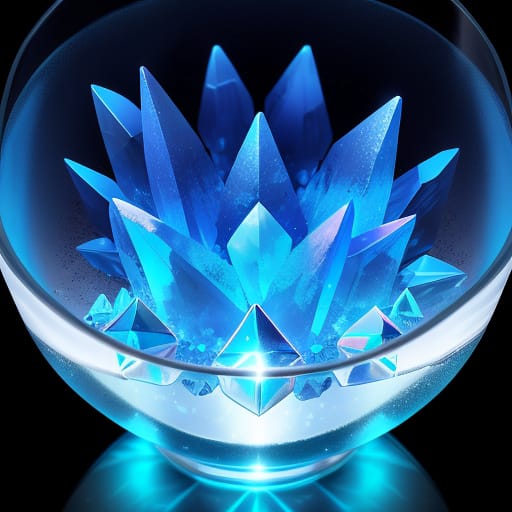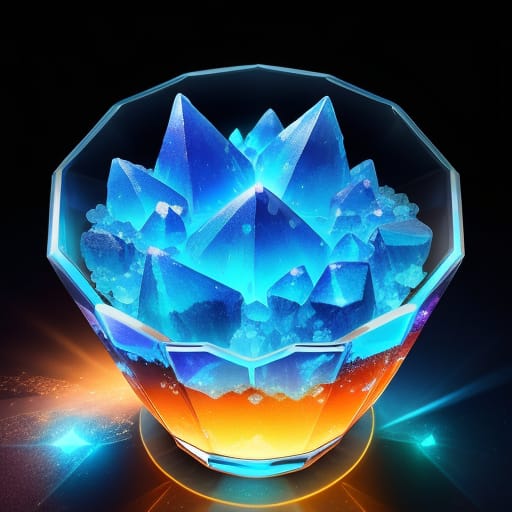Have you ever looked closely at a crystal and marveled at its perfect geometric shape and brilliance? Growing your own crystals is an enjoyable hobby that allows you to produce these stunning creations in your own home. This beginner’s guide will teach you the fundamentals of crystal growing so you can start making your own crystals with minimal supplies.

What Are Crystals and How Do They Form?
A crystal is a solid material whose molecules or atoms are arranged in an orderly, repeating 3D pattern. This organized structure gives crystals their characteristic smooth faces and angular shapes.
In nature, crystals form when minerals slowly solidify from a solution, vapour, or molten fluid. The molecules align themselves symmetrically as the crystal grows. Impurities or environmental factors can cause defects in the pattern, leading to irregularities in the crystal shape.
Many crystalline solids form through precipitation – when dissolved particles clump together and settle out of a fluid. For example, snowflakes form when water molecules crystallize around a speck of dust in the clouds.
The Magic of Growing Your Own Crystals
Growing crystals at home allows you to experience the wonder of creation as you produce gorgeous, sparkling specimens. With a few simple materials, you can easily grow crystals of various shapes, sizes, and colors.
Some of the appeals of crystal growing include:
- Learning about chemistry and physics – Crystal growth demonstrates basic scientific principles like solubility and molecular bonding.
- Trying fun experiments – Crystal growing utilizes household items to produce dazzling results. It’s an enjoyable STEM activity for kids and adults.
- Making natural art – The naturally occurring shapes and colors of crystals have beautiful, mesmerizing patterns.
- Customizing crystals – You can grow crystals of different sizes and colors by tweaking factors like temperature and impurities.
Getting Started with Crystal Growing
Growing your own crystals is easy, but does require some patience. With the right methods and materials, you’ll start seeing results within days or weeks. Here are the basic steps:
1. Choose a Crystal Growing Method
There are several techniques you can use to grow crystals at home:
- Crystal growing kits – Kits contain pre-made crystal growing solutions. Just add water and a seed crystal.
- Preparing crystal solutions – Make your own supersaturated solution using household ingredients like salt, sugar, or borax.
- Rock candy – Grow large sugar crystals on a string or stick suspended in a sugar-water solution.
- Epsom salt crystals – Grow magnesium sulfate crystals by evaporating an Epsom salt solution.
- Geode crystals – Grow alum crystals inside a ball-shaped “geode” made from plaster or eggshells.
2. Gather Your Crystal Growing Supplies
For most methods, you’ll need:
- Crystal growing compounds (like salts, metals, borax, or sugar)
- Distilled or filtered water
- Glass jars or containers
- Food coloring (optional)
- Pieces of string, sticks, or rocks (for seed crystals)
Other supplies like plaster and eggshells are needed for specific techniques.
3. Make a Supersaturated Solution
A supersaturated solution contains more dissolved material than the solvent can normally hold at a given temperature. This unstable solution is necessary for growing large, well-formed crystals.
Heat water to near boiling, then stirs in the crystal growing compound until no more will dissolve. Allow the solution to cool fully before proceeding.
{{Image of crystal growing supplies with supersaturated solution}}
4. Add a Seed Crystal
A tiny “seed” crystal provides a template that determines how the crystalline lattice will form.
Tie a toothpick or string to a small crystal or mineral specimen and suspend it in the cooled solution. You can also place a seed crystal at the bottom of the container.
5. Allow Crystals to Form
Over the next few days to weeks, crystals will slowly grow outward from the seed as solute particles attach to it in all directions. Keep the solution undisturbed and at a constant temperature.
Larger crystals form when growth happens slowly. Patience is key!
6. Harvest Your Crystals
Once the crystals reach the desired size, use tongs to carefully remove them from the solution and allow them to dry on a paper towel. Don’t let them dry too quickly or they may crack.
Admire your homemade crystals sparkling in the light!
{{Image of harvested crystals}}

Types of Crystals You Can Grow at Home
Here are some of the most common and easy crystals to grow using standard techniques:
| Crystal Type | Chemical Formula | Color | Features |
|---|---|---|---|
| Table salt | NaCl | Cubic, colorless | Easy to grow from salt solution |
| Sugar / Rock candy | C12H22O11 | Cubic, colorless | Make giant crystals on strings |
| Borax | Na2B4O7 • 10H2O | Colorless, octahedral | Complex crystal structure |
| Alum | KAl(SO4)2 • 12H2O | Cubic, colorless | Grow as geode crystals |
| Epsom salt | MgSO4 • 7H2O | Long prismatic, colorless | Relaxing bath crystals |
| Copper sulfate | CuSO4 • 5H2O | Blue, triclinic | Stunning deep blue color |
| Potassium ferricyanide | K3Fe(CN)6 | Cubic, yellow | Vibrant yellow crystals |
| Potassium chloride | KCl | Cubic, colorless | Simple ionic crystal structure |
You can create a rainbow of colors by adding food dyes to the crystal growing solutions.
Tips for Growing Large, Perfect Crystals
- Use highly purified water for your solution. Impurities can disrupt crystal formation.
- Carefully follow solution concentration ratios. Too little or too much solute prevents good crystals.
- Avoid vibration or disturbance. Crystals grow best in still conditions.
- Maintain a constant warm temperature around 60-100°F. Rapid temperature shifts cause flaws.
- Use a seed crystal that has a similar structure to your target crystal.
- Be patient! Grow crystals slowly over weeks, not days. Rushed crystals will be small and flawed.
{{Image of large, beautifully formed crystals}}
Simple Crystal Growing Experiments for Kids
Crystal growing is a fun science activity to do with children to teach chemistry basics. Try these kid-friendly experiments:
- Rock candy geodes – Grow candy crystals inside an eggshell “geode” for a delicious treat!
- Borax snowflakes – Grow flakes of borax in a jar for an icy crystal snow globe effect.
- Ocean treasure crystals – Simulate seawater crystals growing on a shell or piece of coral.
- Crystal sun-catchers – Suspend crystals from pipe cleaner shapes to make sparkly sun-catchers.
- Crystal mineral gardens – Layer crystal growing solutions of different densities to create a colorful mineral garden.
- Crystal guessing game – Grow various crystal types, then challenge kids to identify them.
Make sure kids wear safety goggles and have adult supervision when growing crystals.
The Science Behind Crystal Growing
Now that you know the basics of crystal growing, let’s look at some of the science behind this fascinating process:
- Crystallization depends on reaching a supersaturated solution – when more solute is dissolved than is normally possible under given conditions. This unstable state allows molecules to readily form the organized structure of a crystal.
- Temperature and pressure changes affect solubility. Heating increases the solubility of most substances, while cooling decreases solubility and encourages crystallization.
- Impurities can disrupt the orderly crystalline pattern. Ultrapure water and filtered solutions create the best crystal growth.
- The Repeating microscopic lattices reflect and amplify light, producing the sparkling brilliance of macroscopic crystals.
- Ionic compounds like salts crystallize when oppositely charged ions attract and bond together in a rigid formation.
- Molecular crystals form as individual molecules align in symmetrical patterns based on their shape and bonding properties.
Understanding these basic principles of chemistry and physics will help you grow large, perfect crystals.

Growing Crystals Takes Patience and Precision
With its dazzling results and educational benefits, crystal growing is a worthwhile hobby for both kids and adults. By carefully following solution recipes and using proper techniques, you can grow incredible crystals at home. Have patience, avoid disturbances, and be amazed at these wonders of natural science sprouting before your eyes!
To learn more about crystal growing, check out these helpful resources:
- Crystal Growing Education Website
- Crystal Growing for Beginners Book
- Video: How to Grow the Best Crystals at Home
Frequently Asked Questions About Growing Crystals
What are the best crystal growing kits for beginners?
Some of the top beginner crystal growing kits are the GeoCentral Rock Factory kit, the National Geographic Crystal Growing lab, and the 4M Crystal Growing Science kit. These contain all the materials and instructions needed to grow starter crystals. The GeoCentral kit lets you grow many crystal types like salt, alum, and Epsom salt.
What crystal growing chemicals are safe?
Most common crystal growing chemicals like table salt (sodium chloride), sugar (sucrose), borax, alum (potassium aluminum sulfate), and Epsom salts (magnesium sulfate) are safe for home use. Always wear gloves and goggles and keep chemicals away from children and pets. Avoid toxic metals like lead and nickel.
How do I make the best crystal growing solutions?
Use purified or distilled water to prevent impurities. Carefully follow recipes to reach the proper supersaturation for crystal growth. Heat the water to fully dissolve the chemicals, then allow it to fully cool before adding seed crystals. Keep the crystal growing solution in a quiet place with a stable temperature of around 60-100°F.
What causes common crystal growing problems?
Issues like small size, flaws, or slow growth often stem from rapid temperature changes, vibration, impure water, incorrect chemical ratios, or impatience. Crystal growing requires pristine conditions and time for molecules to align properly. Avoid jostling containers or changing temperatures drastically.
How can I display my grown crystals?
Grown crystals make beautiful decorations and educational displays. Place small crystals in glass vases or bowls to showcase their natural geometry. For larger crystals, use acrylic stands, mounts, or hanging wires to create an art piece. Label your crystals and note the crystal growing details.